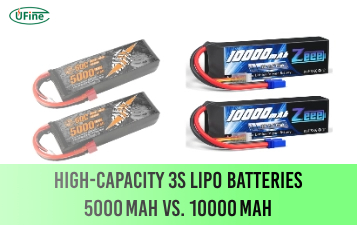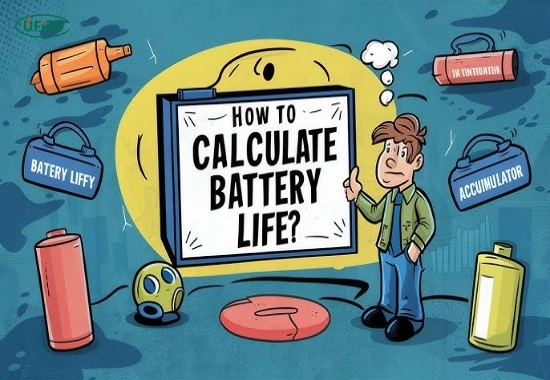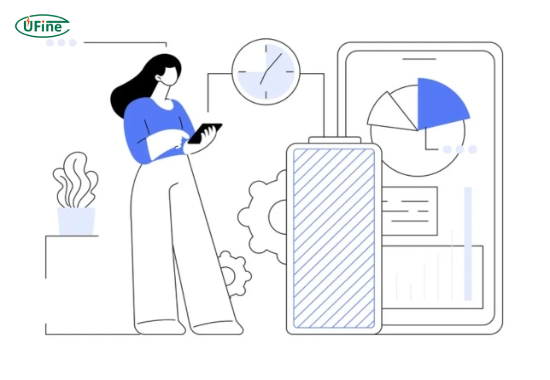How do you calculate battery run time? In this guide, we’ll cover how to calculate battery run time, understand the factors that influence it, and introduce a battery run time formula calculator for your devices.
Part 1. What does battery run time mean?
Battery run time refers to the duration for which a battery can power a device continuously before needing to be recharged or replaced. It is the duration for which a device can operate on a single battery charge.
For example, suppose a smartphone has a battery run time of 10 hours. In that case, the device can operate for 10 hours under normal usage conditions before requiring a recharge. Understanding battery run time allows users to manage their device usage effectively, mainly when access to power sources is limited or unavailable.
Part 2. How to calculate battery run time easily?
To calculate battery run time, follow a simple formula that considers the battery’s capacity and the device’s power consumption.
Battery run time can be calculated using the following simple formula:
- Battery Run Time (in hours) = Battery Capacity (in mAh or Wh) / Device Power Consumption (in mA or W)
For instance, if you have a 3000mAh battery and the device uses 100mA, the run time would be:
Run Time = 3000mAh / 100mA = 30 hours
- Determine Battery Capacity: First, determine the battery’s capacity. Typically, people measure battery capacity in milliampere-hours (mAh) or watt-hours (Wh). You can generally find this information on the battery or the device’s specifications.
- Identify Device Power Consumption: Next, determine the power consumption of the device that the battery powers. Typically, people measure battery power consumption in watts (W) or milliamps (mA). You may need to consult the device’s user manual or specifications for this information.
- Apply the Formula: Once you have the battery capacity and device power consumption, you can calculate battery run time.
Why Use a Battery Run Time Calculator?
- Accuracy: Avoid manual errors in complex calculations.
- Speed: Achieve instant results across various devices.
- Versatility: Works for mAh, Wh, solar panels, and inverters.
Part 3. Battery run time calculator: Step-by-step guide
To simplify calculations, use the following battery run time calculator formula:
| Input | Example | Formula |
|---|---|---|
| Battery Capacity (mAh) | 3000mAh | Runtime (hours) = Battery Capacity ÷ Device Consumption |
| Device Consumption (mA) | 200mA | |
| Result | 15 hours |
Steps to Use the Calculator:
- Find battery capacity (in mAh or Wh).
- Check device power consumption (in mA or W).
- Divide capacity by consumption for runtime.
Part 4. Understanding the battery run time formula
The battery run time formula relies on understanding the relationship between amperes (amps), watts, and volts. Here’s a brief explanation of how these units are related:
Amperes (A): Amperes represent the rate of electrical flow in a circuit. It measures the amount of electric charge passing through a point in the circuit per unit of time.
Formula: I = Q / t
Where:
- I = Current (in amperes)
- Q = Electric charge (in coulombs)
- t = time (in seconds)
Volts (V): Volts indicate the electrical potential difference between two points in a circuit. It represents the force or pressure that drives the electric current.
Formula: V = W / Q
Where:
- V = Voltage (in volts)
- W = Work done (in joules)
- Q = Electric charge (in coulombs)
Watts (W): Watts measure a circuit’s energy transfer or consumption rate. It represents the amount of work done per unit of time.
Formula: P = V * I
Where:
- P = power (in watts)
- V = Voltage (in volts)
- I = Current (in amperes)
Part 5. Battery run time calculation examples
Here are case studies demonstrating how to calculate battery run time for various devices and scenarios:
Example 1: Power Tool
Using the battery run time calculator formula:
- Battery Capacity: 4000mAh
- Device Power Consumption: 500mA
To calculate the battery run time:
Battery Run Time (in hours) = Battery Capacity (in mAh) / Device Power Consumption (in mA)
= 4000mAh / 500mA
= 8 hours
In this scenario, a power tool with a battery capacity 4000mAh and a power consumption of 500mA can operate continuously for approximately 8 hours on a single charge.
Example 2: Laptop
- Battery Capacity: 5000mAh
- Device Power Consumption: 1A (1000mA)
To calculate the battery run time:
Battery Run Time (in hours) = Battery Capacity (in mAh) / Device Power Consumption (in mA)
= 5000mAh / 1000mA
= 5 hours
For a laptop with a capacity of 5000mAh and power consumption of 1A (1000mA), the battery can last about 5 hours before recharging.
Example 3: Smartphone (Connected to Wh and V)
- Battery Capacity: 3000mAh (or 3Ah)
- Device Power Consumption: 200mA (or 0.2A)
- Battery Voltage: 3.7V (typical for lithium-ion smartphone batteries)
To calculate the battery capacity in watt-hours (Wh):
Battery Capacity (in Wh) = Battery Capacity (in Ah) * Battery Voltage (in V)
= 3Ah * 3.7V
= 11.1Wh
Now, using the battery run time formula:
Battery Run Time (in hours) = Battery Capacity (in mAh) / Device Power Consumption (in mA)
= 3000mAh / 200mA
= 15 hours
Example 4: Flashlight (Connected to mA and mAh)
- Battery Capacity: 1000mAh (or 1Ah)
- Device Power Consumption: 50mA (or 0.05A)
We need to know the Voltage to calculate the battery capacity in watt-hours (Wh). Let’s assume a standard voltage for flashlight batteries, such as 1.5V:
Battery Capacity (in Wh) = Battery Capacity (in Ah) * Battery Voltage (in V)
= 1Ah * 1.5V
= 1.5Wh
Now, using the battery run time formula:
Battery Run Time (in hours) = Battery Capacity (in mAh) / Device Power Consumption (in mA)
= 1000mAh / 50mA
= 20 hours
These examples showcase how to apply different units and formulas to calculate device battery run time.
Example 5: Solar Panel Battery
- Battery Capacity: 150Ah
- Device Power Consumption: 300W
To calculate the battery run time for a solar panel system, we use the formula:
Battery Run Time (in hours) = Battery Capacity (in Ah) / Device Power Consumption (in W)
= 150Ah / 300W = 0.5 hours
This solar panel battery would last for approximately 30 minutes when powering a 300W device. However, this calculation can vary based on the solar panel’s output and sunlight hours.
Pro Tip: Use a solar battery run time calculator to factor in sunlight hours and panel efficiency.
Part 6. Factors influencing battery run time
Battery Capacity
The capacity of the battery, typically measured in milliamp-hours (mAh) or watt-hours (Wh), directly impacts its runtime. A higher-capacity battery can provide longer run times compared to a lower-capacity one.
Device Power Consumption
The device connected to the battery determines how quickly it will deplete based on its power consumption. Devices with higher power consumption rates drain the battery faster, resulting in shorter run times.
Battery Age
As batteries age, their capacity decreases, resulting in shorter run times. Factors such as the number of charge cycles, temperature exposure, and overall usage patterns contribute to battery degradation over time.
Temperature
Battery performance is sensitive to temperature. Both extreme heat and cold can impact battery efficiency, resulting in reduced run times.
To ensure optimal performance, keep devices within recommended temperature ranges. This will help maintain battery capacity and extend run time.
Usage Patterns
The way users interact with the device significantly impacts battery runtime. Intensive tasks, such as gaming or video streaming, consume more power and shorten run times compared to lighter tasks, like browsing or reading.
Screen Brightness and Connectivity
Settings such as screen brightness level and connectivity options (Wi-Fi, Bluetooth, GPS) impact power consumption. Higher screen brightness and active connectivity features drain the battery faster, reducing run times.
Background Processes
Background apps and processes running on the device consume power even when not in use, which affects battery runtime. Closing unnecessary apps and minimizing background processes can conserve battery life.
Battery Chemistry
Different battery chemistries, such as lithium-ion (Li-ion) or nickel-metal hydride (NiMH), have varying energy densities and discharge characteristics, influencing battery run time.
In the conclusion
Now that you know how to calculate battery run time and the factors that affect it, use our battery life calculator to estimate your device’s battery performance.
Battery Technology Decoded
Part 7. FAQs about battery run time calculator
How long will a 100Ah battery last?
A 100Ah battery lasts 10 hours with a 10A device. Use the formula: Runtime (hours) = 100Ah ÷ Device Current (A).
How long will a 100Ah battery run a 400W appliance?
At 12V: 400W ÷ 12V = 33.3A. Runtime = 100Ah ÷ 33.3A = 3 hours. Always check voltage compatibility.
How to calculate solar battery run time?
Use: Solar Runtime = (Battery Capacity × Voltage) ÷ Device Wattage. Include 20% losses for accuracy.
How to calculate battery run time for an inverter?
Runtime = (Battery Ah × Voltage) ÷ (Inverter Load Watts × 1.1). The 1.1 factor accounts for inverter inefficiency.
How to use a battery run time calculator?
Enter battery capacity (e.g., 5000mAh) and device consumption (e.g., 200mA). The calculator will output: 5000 ÷ 200 = 25 hours.
Do lithium batteries last longer than lead-acid?
Yes. Lithium-ion batteries provide 2-3x longer runtime than lead-acid at the same capacity due to higher energy density.
Does cold weather reduce battery life?
Yes. Below 0°C, lithium batteries lose up to 30% capacity. Keep devices in warm conditions for optimal runtime.
Related Tags:
More Articles

High‑Capacity 3S LiPo Batteries: 5000 mAh vs. 10000 mAh
Compare 3S LiPo 5000mAh vs 10000mAh batteries by weight, power, and use. Find the best fit for your drone, RC car, or boat setup.
Top 5 Applications for Small 3S LiPo Batteries
Small 3S LiPo batteries power drones, RC gear, wearables, and robotics with high energy and low weight. Making them ideal for compact electronics projects.
Building and Charging Your Own 3S LiPo Pack: A Step‑by‑Step Guide
Learn how to build, balance, and charge a 3S LiPo battery pack safely at home with this complete DIY guide for hobbyists and beginners.
How to Choose the Right LiPo Battery Plug Type?
Discover the best LiPo battery plug types, how to choose them, and expert tips for safe usage, soldering, and maintenance.
Choosing the Right Connector for Your 3S LiPo Battery
Choosing the right 3S LiPo connector depends on current, space, and use. Learn the pros and cons of XT60, JST, EC3, and more.






